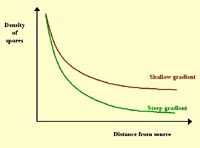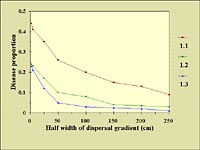The shape of a pathogen's dispersal gradient and its interaction with genotype unit area influences the effectiveness of cultivar mixtures for disease suppression. Steeper dispersal gradients result in more inoculum loading on the plant (genotype) on which it was produced, with fewer spores lost as a result of the dilution or barrier effects. Consequently, splash-dispersed pathogens are less suited to control by cultivar mixtures than are wind-dispersed pathogens.
 |
|
Examples of spore dispersal gradients. Click image for an enlarged view. |
 |
|
Computer simulations have illustrated that cultivar mixtures are most effective in reducing spread of diseases caused by pathogens with shallow spore dispersal gradients. This figure shows the predicted effect of the relative steepness of the spore dispersal gradient on the amount of disease in three mixtures of susceptible and resistant cultivars (ratio of susceptible to resistant cultivars = 1:1, 1:2, and 1:3) after six pathogen generations in a model simulating barley powdery mildew (Fitt and McCartney 1986). Note: steep gradients have small half widths. Click image for an enlarged view. |
